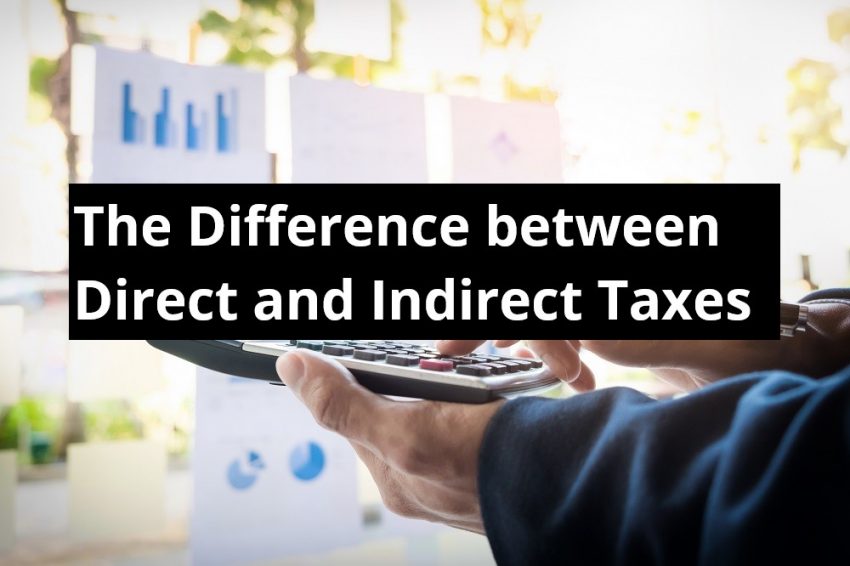The tax legislation in the UAE aims to achieve social justice and diversify sources of revenue, in order to achieve many development goals to redistribute them in the service of society.
There are various forms of taxes, including direct and indirect taxes, and this article will endeavor to explain the differences between them.
Direct Taxes
Direct Tax is a tax imposed by persons and their direct inputs or what they own. This tax is paid directly to the state by the taxpayer.
Direct taxes are levied on personal ownership or personal acquisition, such as the income of individuals, commercial and industrial profits of companies, real estate assets, and properties.
Types of Direct Taxes
- Income Tax: It is the tax that is imposed on various sources of income, such as capital, work, industrial and commercial businesses, or liberal professions, and each source of them leads to an income called sub-or specific income.
- Capital Tax: It is the tax imposed on the capital that constitutes the movable, intangible, real estate, and material financial assets that a person owns.
Advantages of Direct Taxes
- The principles of tax justice are observed, so each taxpayer pays according to his own mandate.
- Its outcome is relatively stable because it is imposed on sources that are characterized by relative stability, such as wealth and income.
- The ability of the tax administration to achieve an adequate payment base is greater in respect of direct taxes.
- The collection of Direct tax is easy and relatively simple, as it includes only two parties, namely, the individual taxpayer and the tax authority.
- It achieves social justice, as it is imposed at progressive rates according to income brackets, property value, or profit volume.
- Direct taxes are an important tool for combatting social inequalities created by income and wealth.
- It does not cause distortion in the allocation of resources and does not affect the relative prices of goods and services. Thus, leaving the relative profitability of different industries unchanged.
- Direct Tax revenues offer a certain level of flexibility, and as national income increases, revenues from these taxes may also rise significantly.
Disadvantages of direct taxes on an individual
- The individual's feeling of state interference in his economic affairs may lead to attempts at tax evasion.
- The collection of tax revenues is directly linked to the end of the fiscal year, which does not necessarily correspond to the state's expenditures.
- The tax burden imposed on those with higher income and valuable real estate is greater.
Here are some further disadvantages of Direct Tax which will be discussed in more detail below:
Direct Taxes May Reduce Business Effort
If its marginal rates are too high, it reduces the individual’s desire to exert greater productive effort. Thus, excessive income tax levies may provide less labor for productive work or reduce the size of the supply of labor performance in the economy and thereby adversely affecting economic growth.
Direct Taxes Reduce Saving Incentives
One of the major detrimental effects of direct taxes is that they reduce the incentives to save and invest as a direct tax, like income tax, reduces the rate of return on investment as a portion of the return is reduced by the tax. This induces individuals to substitute current consumption for saving and investment.
Corporate Income Tax Adversely Affects Investment
The imposition of corporate income tax reduces investable funds, delaying investment, and growth. To overcome this deficiency in corporate income tax, provisions have been made to exempt depreciation funds from income tax and also to provide investment credit in budgets.
Indirect Taxes
Indirect tax is that which is collected for the government through an intermediary, for example, taxes on sales, value-added tax, taxes on imports, exports and production, customs duties, interests of government agencies, consumption, etc.
The most well-known example of Indirect Tax is what is known as Value-Added Tax (VAT), which is borne by the consumer in full. VAT is collected through stores and points of sale and is calculated as a percentage of the total amount spent on the purchase.
Some countries may exclude some basic goods and services from Indirect Tax in order to avoid increasing the burden on consumers, or they may resort to an increase in Indirect Taxes on certain items in order to avoid consumption as such items are harmful to public health.
Advantages of Indirect Taxes
Wide Coverage
The main advantage of indirect tax is that it affects all income groups. Indirect taxes, such as sales tax or consumption tax, are levied equally on all consumers or buyers regardless of their income.
Consumption Control
By imposing an Indirect Tax, the consumption of items harmful to public health can be reduced. For example, by imposing excise duties on wine and cigarettes, the government discourages the consumption of these harmful products.
Popularity
People are not always aware of indirect taxes because in most cases they are combined with the prices of goods and the consumer does not know how much he pays with the price and how much he pays as an indirect tax. The consumer is only aware of the total price paid and does not really feel the effect of the indirect tax.
Productivity
Indirect Tax expands government revenue and through the imposition of indirect taxes, the tax net is expanded more widely and all persons are mandated to contribute to the National Fund.
Disadvantages of Indirect Taxes
Regressive Character
A commodity tax imposed on foodstuffs affects the poorest members of society to a much greater degree than those in a better financial position.
Administrative Difficulties
The collection of indirect taxes creates various administrative problems. The collection of indirect taxes such as customs duties often involves large expenditures. There is also the possibility of evasion.


